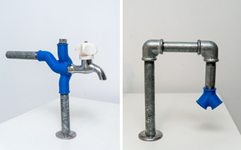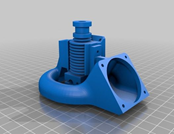 Just as buildings come in all shapes and sizes, the plumbing system required for human occupants comes in all shapes and sizes. The plumbing of a building includes the supply of water and waste lines. When a building is constructed, a plumber will run a supply line from the street into the structure. These lines will supply water to rooms where there are sinks, bathtubs, shower fixtures and other water needs.
Just as buildings come in all shapes and sizes, the plumbing system required for human occupants comes in all shapes and sizes. The plumbing of a building includes the supply of water and waste lines. When a building is constructed, a plumber will run a supply line from the street into the structure. These lines will supply water to rooms where there are sinks, bathtubs, shower fixtures and other water needs.
It is a mandate for the plumbing system to keep a building and its occupants safe and stay compliant with health and sanitary codes. A specialized building code strictly regulates plumbing systems. A specialized plumbing inspector often checks the installation when the pipes are being put in, once the building is finished, and then right before human occupancy. There are a myriad of opportunities for utilizing 3D printers in the plumbing industry. An engineer, designer, MEP contractor or plumbing supply house that 3D prints plumbing parts may be eligible for R&D Tax Credits.
The Research & Development Tax Credit
Enacted in 1981, the now permanent Federal Research and Development (R&D) Tax Credit allows a credit that typically ranges from 4%-7% of eligible spending for new and improved products and processes. Qualified research must meet the following four criteria:
- Must be technological in nature
- Must be a component of the taxpayer’s business
 Must represent R&D in the experimental sense and generally includes all such costs related to the development or improvement of a product or process
Must represent R&D in the experimental sense and generally includes all such costs related to the development or improvement of a product or process- Must eliminate uncertainty through a process of experimentation that considers one or more alternatives
Eligible costs include US employee wages, cost of supplies consumed in the R&D process, cost of pre-production testing, US contract research expenses, and certain costs associated with developing a patent.
Copper Piping and Plumbers
 Copper piping is the traditional material that is used for water supply lines, although some plastic piping materials are gaining popularity. Drain waste pipes are usually plastic and can be 3D printed. 3D printers that use plastic filaments can develop piping that is durable and able to be used as part of a building’s plumbing system. These pipes serve to carry waste down and away from the home and allow the sewer gases to be pushed out through the roof. The common material that is used for plumbing is acrylonitrile butadiene styrene (ABS). This petroleum-based material is part of the thermoplastic polymers and comes in various grades. A strong material, it is affordable and easy to modify which is perfect when inserted into a 3D printer. Once inserted, the filament flows from the print head and shrinks as it cools down
Copper piping is the traditional material that is used for water supply lines, although some plastic piping materials are gaining popularity. Drain waste pipes are usually plastic and can be 3D printed. 3D printers that use plastic filaments can develop piping that is durable and able to be used as part of a building’s plumbing system. These pipes serve to carry waste down and away from the home and allow the sewer gases to be pushed out through the roof. The common material that is used for plumbing is acrylonitrile butadiene styrene (ABS). This petroleum-based material is part of the thermoplastic polymers and comes in various grades. A strong material, it is affordable and easy to modify which is perfect when inserted into a 3D printer. Once inserted, the filament flows from the print head and shrinks as it cools down
Usually water pipes have a standardized structure to them. The fittings are 90 degree, 45 degree and T shape angles and the pipes are joined together in these settings only. However, what if these pipes could be printed using additive manufacturing? By using additive manufacturing, water pipe fittings can be designed with bends that are innovative and an alternate solution to the typical joint bends. Using a 3D printer allows designers and construction workers to work with the pipes the way they want to. They are able to make and bend them in any fashion they choose as long as they meet the needed requirements.
3D Printed Parts
3D printed product designs are flexible and can fix any mechanical needs. Use a 3D printer to make pipe connectors. If the piping is running in a 45-90 degree angle and the connectors don’t work efficiently, then 3D print your own custom connector. These connectors hold the pipes in place and allow for rapid and simple fixes. Maya Ben David, a designer from Israel, has 3D printed various piping and water systems. The Bypass project is where 3D printing is used to produce the fittings. Bypass presents a range of pragmatic solutions in a systematic way, by creating a range of possibilities for pipe fittings that are also compatible with existing standards.
Printing Threaded Caps
 A plumbing system is a network of pipes and fixtures in a building. Sometimes even the best designed plumbing systems can have design problems. When a pipe gets clogged a clean-out is needed. Usually, a plumbing system has one or more clean-outs that can be regulated from the inside or outside of a house. An inside clean-out is usually done where grime gets clogged in the pipes such as at a joint or a point where two pipes are connected. Another location for grime to collect is where the stack pipe meets the underground building sewer. The clean-out points on the outside can easily be identified. There is a removable threaded cap that has a square fitting that can be opened with a wrench. This part can be 3D printed as well from a desktop printer.
A plumbing system is a network of pipes and fixtures in a building. Sometimes even the best designed plumbing systems can have design problems. When a pipe gets clogged a clean-out is needed. Usually, a plumbing system has one or more clean-outs that can be regulated from the inside or outside of a house. An inside clean-out is usually done where grime gets clogged in the pipes such as at a joint or a point where two pipes are connected. Another location for grime to collect is where the stack pipe meets the underground building sewer. The clean-out points on the outside can easily be identified. There is a removable threaded cap that has a square fitting that can be opened with a wrench. This part can be 3D printed as well from a desktop printer.
Toilet Sinks
In micro apartments there may not be enough space for a sink and toilet. You can have a 3D printed sink that is hooked up and sits on top of your toilet. This way you can save water and space with the “toilet sink.” As 3D printers get better and printed materials are improving, the quality and finish of prototypes are becoming harder to distinguish from objects that are made in traditional factories. Essentially one day, most of our appliances including our plumbing infrastructure will be 3D printed as well.
Conclusion
 Innovative approaches using 3D printing technology are helping business component designers and engineers to provide improved plumbing systems for plumbing supply houses. Those individuals who are involved with 3D printing of plumbing, pipes, fixtures and accessories may be eligible for R&D Tax Credits.
Innovative approaches using 3D printing technology are helping business component designers and engineers to provide improved plumbing systems for plumbing supply houses. Those individuals who are involved with 3D printing of plumbing, pipes, fixtures and accessories may be eligible for R&D Tax Credits.
Discuss this and other 3D printing topics at 3DPrintBoard.com or share your thoughts below.
Charles Goulding and Alize Margulis of R&D Tax Savers discuss 3D printing in the plumbing industry.
Subscribe to Our Email Newsletter
Stay up-to-date on all the latest news from the 3D printing industry and receive information and offers from third party vendors.
You May Also Like
Profiling a Construction 3D Printing Pioneer: US Army Corps of Engineers’ Megan Kreiger
The world of construction 3D printing is still so new that the true experts can probably be counted on two hands. Among them is Megan Kreiger, Portfolio Manager of Additive...
US Army Corps of Engineers Taps Lincoln Electric & Eaton for Largest 3D Printed US Civil Works Part
The Soo Locks sit on the US-Canadian border, enabling maritime travel between Lake Superior and Lake Huron, from which ships can reach the rest of the Great Lakes. Crafts carrying...
Construction 3D Printing CEO Reflects on Being Female in Construction
Natalie Wadley, CEO of ChangeMaker3D, could hear the words of her daughter sitting next to her resounding in her head. “Mum, MUM, you’ve won!” Wadley had just won the prestigious...
1Print to Commercialize 3D Printed Coastal Resilience Solutions
1Print, a company that specializes in deploying additive construction (AC) for infrastructure projects, has entered an agreement with the University of Miami (UM) to accelerate commercialization of the SEAHIVE shoreline...































